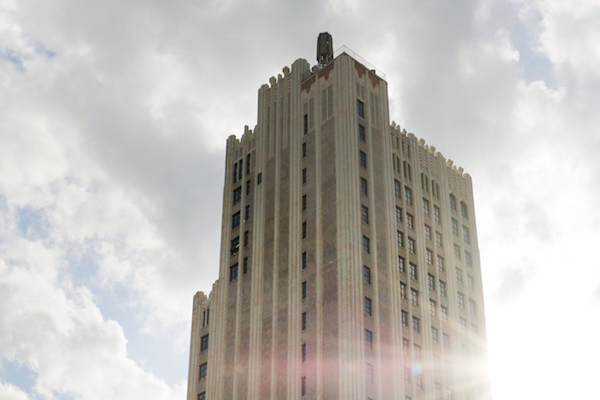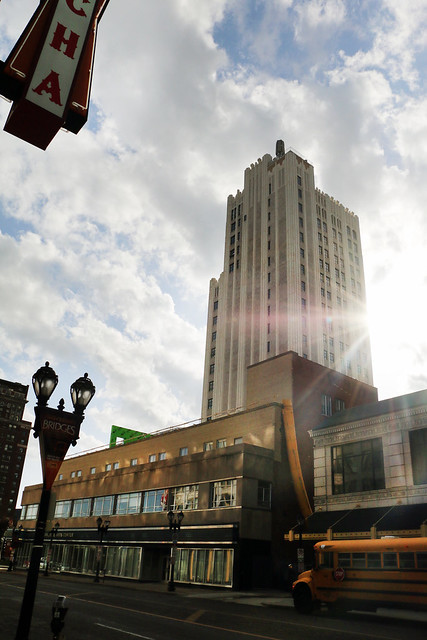
The New Roots of Grand Center
Though KDHX called South City home for over two decades before recently relocating to Grand Center, the station has always been rooted in a community that reaches far beyond the St. Louis area. For a freeform radio signal, KDHX's is among the strongest in the country.
The broadcast tower in Arnold carries our signal well past Hermann to the west, St. Genevieve to the south, Grafton to the north, and on a good day as far northeast as Carlyle Lake. With that signal also streaming through kdhx.org, the shows on our station find their way into communities across the country and even world. (During my first show I received a complaint call from Belize.) None of that changes the fact that KDHX's 2013 relocation to the Larry J. Weir Center for Independent Media meant for us a new commitment to Grand Center as both an arts district and neighborhood. KDHX is about to deepen that commitment with the inauguration of KDHX Fest on May 22, with performances and merrymaking at the Stage and in Strauss Park. As in past years with Midwest Mayhem, this festival is a way of thanking the volunteers and donors who have sustained KDHX as we adapt to our expanded responsibilities and new location. KDHX would not be here without the time and money our community has contributed. To that community we owe daily thanks, hourly thanks -- gratitude down to every second we broadcast. But even as KDHX Fest celebrates community giving by extending special invitations to our donors and volunteers, the choice of venue also extends a broader invitation to our listeners to explore the historic district into which we're branching our roots.
Once home to numerous theaters, vaudeville houses, nightclubs, dance halls, burlesques, and cinemas, Grand Center was one of the great nightlife destinations not only in the city but the country. As often happens, the booms and busts of urban centers -- combined with a tremendous lack of foresight -- led to the demolition of would-be landmarks. The Princess Theater, a vaudeville house, was the first to open in 1912. The building was known best or most infamously in its later life as Loew's Mid-City. After a slow slide into raunchier fair throughout 1969, culminating in a three week-long run of Russ Meyer's now cult classic Vixen, which started the day after Christmas, the Mid-City was raided by vice squad police and three of its employees arrested, including the manager. Lowe's departed in 1972 and the Mid-City was torn down in 1978 after a brief stint under new management. The second theater to open in the area and first true cinema in the city, Grand Central Theatre, was torn down in 1948 and replaced by a parking lot, a fate shared about a decade later by the 3,690 seat Missouri Theater (626 N. Grand) which opened in 1920 on the site of the razed St. Vincent's Seminary building, later Rosati-Kain's first location. In 1966, the Arcadia Ballroom (aka Dreamland, aka Tune Town) -- once host to great jazz orchestras from Duke Ellington to Stan Kenton -- was also razed for a parking lot.
To be sure, the threat of demolition still looms for historic buildings in the area that have not yet been put on the National Register of Historic Places, such as the endangered Palladium building at 3618 Enright. What remains -- and that's a lot -- deserves our affection. The rising art-deco facade of the Continental Life Building is simply spectacular. Walking beneath the iconic awning of the Fox Theater (originally built by William Fox, founder of the ubiquitous production company) or looking down from the balcony of Powell Hall -- initially RKO's vaudeville house, the St. Louis Theater -- it's hard not to feel a connection to that era of fedoras. But any nostalgia for what was once called St. Louis' "Great White Way" is misplaced.
The difference between the old Grand Center and the new Grand Center is that it was not so much an arts district as one devoted to entertainment. The notable exceptions to this were Sheldon Hall, home of the Ethical Society of St. Louis until 1964, as well as the St. Louis headquarters of the Knights of Columbus and the Knights of Pythias in the buildings now known respectively as the Centene Center and the Carter Carburetor Building. If there was a great old time to be had watching Al Jolson's The Jazz Singer when it premiered, taking in one of the vaudeville shows that inspired the film's story, or marveling at the Missouri Rockettes, one did not seek out the intersection for cultural appreciation in the way one would do so today. Certainly, one didn't seek it out for the educational opportunities offered by many of the institutions now in the area. Venues like the Club Plantation, which first occupied the Palladium Building, may have given the stage to the likes of Ella Fitzgerald and Nat King Cole and played home to the great Jeter Pillars Orchestra. But blues and jazz as they were performed to a whites-only audience is not the sort of thing to be nostalgic about, even if the spaces of those performances deserve preservation as a memorial to musicians who still give so much to music but got so little in their own time.
As the old Grand Center rose and fell with the vicissitudes of its entertainments -- once defining buildings repurposed, boarded-up, or torn down for parking lots -- the new Grand Center found its beginnings in the 1966 relocation of the St. Louis Symphony, previously located downtown in the Kiel Opera House. Largely credited to Paul Reinert, then President of St. Louis University, the plan to use arts institutions to revitalize urban areas had been famously implemented earlier in the decade with the "Lincoln Square Renewal Project." The results, of course, are the landmark performance halls that opened in Midtown Manhattan as their construction was completed over the course of the 60s. In the case of Lincoln Center, however, redevelopment meant clearing over a dozen ethnically populated blocks (of West Side Story fame). Needless to say, the neighborhood was decisively changed as a result of this urban renewal use of eminent domain. In St. Louis history, similar destruction was brought to predominantly African-American neighborhoods, including portions of the Hill and the now non-existent Pleasant View as the city's implemented the Federal-Aid Highway Act to build I-44 and I-55, which continue to divide the city.
Fortunately, following the repurposing of the St. Louis Theater as Powell Hall, arts-district redevelopers have shifted emphasis over the years to privilege the renovation of derelict historic buildings, rather than razing history in the name of the arts. The First Congregational Church, built in 1884, has become Grandel Theatre and Ballroom. What was long called the Midinah Temple, originally designed as a dance academy, has become the Centene Center for Arts and Education. The former Woolworth's lunch counter on the northwest corner of Grand and Olive -- another whites-only establishment -- has been transformed into the Kranzberg Arts Center and the home of Big Brothers, Big Sisters of Eastern Missouri which is in the process of completing a rooftop bar and restaurant, revenue from which will sustain the youth-mentoring organization. And the last vacant building at the intersection, the Missouri Theater Building, is well into its renovation and expected to open next year as an office building with a hotel and what one can expect to be a street-level restaurant venue, among other facilities and consumer spaces.
In this new Grand Center, the oldest establishments are those that have kept their doors open as others were putting plywood up in the windows. That means the Third Baptist Church, on its present site since 1885, and The Best Steakhouse, open since 1964 and one of the stand-out eateries in the city as far as I'm concerned. These Grand Center institutions weathered some of the hardest years as perhaps the same crowds that once lined up outside Club Plantation or perched on stools at the Woolworth counter dispersed into County suburbs with the rise of commuter culture. If we should be grateful for the preservation of all this historic building stock -- as well the world-class contemporary designs of the Pulitzer and CAM -- we should also be grateful that the buildings of the old Grand Center are being filled with a diversity of institutions serving a distinctively broad community.
The new Grand Center is more than an entertainment strip of crowd-luring bright lights, and it's also more than an arts district. If the first signal of change was the relocation of the St. Louis Symphony, the second was the 1998 relocation of the Nine Network, KETC, which facilitated the construction of the Tadao Ando design for the Pulitzer Arts Foundation. Now, in addition to KETC Channel 9, both 90.7 KWMU St. Louis Public Radio and 88.1 KDHX broadcast from Grand Center headquarters. In other words, Grand Center is also a media district. And perhaps most importantly, it's becoming an educational district.
While still drawing crowds to Broadway plays and symphonic performances, Grand Center institutions reach out through a range of educational opportunities in keeping with the idea that education builds the common ground on which these buildings truly find their foundation. CAM offers in-house art courses for pre-teens and teens as well as ArtReach, which brings arts instruction to public schools. The Craft Alliance of Art and Design offers numerous studio classes on working with clay, wood, textiles, glass, and metal. In addition to Jazz at the Bistro performances by world-class artists, Jazz St. Louis offers JazzU music instruction and the Emerson Jazz outreach program. The Folk School at KDHX continues to offer low-cost musical instruction including guitar, banjo, mandolin, and fiddle. And the Grand Center Arts Academy recently opened their doors as a public charter school for the arts in the Carter Carburetor complex. This is to only name a few such programs by only a handful of the organizations calling Grand Center their home.
So, while driving west on Washington to an event at the Stage, be sure to catch a little light from the earlier days of Grand Center in the neon rays around the KDHX logo on the east face of the Larry J. Weir Center. They're taken from from the old Sun Theater, renovations to which were completed in 2014. But as fabulous as the Fox, as dizzying as the Continental Life Building, as grand as it all is becoming -- don't look past the message in what could have become a landmark ruin of the area: the remains of the late 19th century church on the corner of Spring and Grandel Square, now only a face and walls after a 2001 electrical fire took the home of the National Memorial Church of God in Christ that had congregated there since the early 70s. I have not been able to find out what happened to its flock, but the arresting encounter with all that empty space between its walls always seems to send me a message from the past: that the care and support of a sustaining community and the care and protection of that community's building are one and the same.
In this long history of Grand Center, KDHX is a newcomer. I believe I speak for most, if not all, of our DJs when I say that our only true home is and always will be 88.1 FM, but we have also merged our on-the-ground mission with the future of this historic intersection. As we do, whether touring the station's new facilities, attending an event at the stage, or helping us celebrate donors and volunteers at the upcoming KDHX Fest, take a little time to look around and consider that the Grand Center story isn't just the boom of an arts district under the auspices of urban renewal, it is and should be a community in the making.
Click here to see the complete photo set. All photos by Nathaniel Farrell.
Unless otherwise indicated, research for this article has been drawn from the archives of the St. Louis Post-Dispatch and Norbury L. Wayman's Neighborhood Histories (1978). If you would like to take a tour of Grand Center and learn more about it's history, Grand Center, Inc. will be offering guided tours Saturdays, May 7 through June 25.




